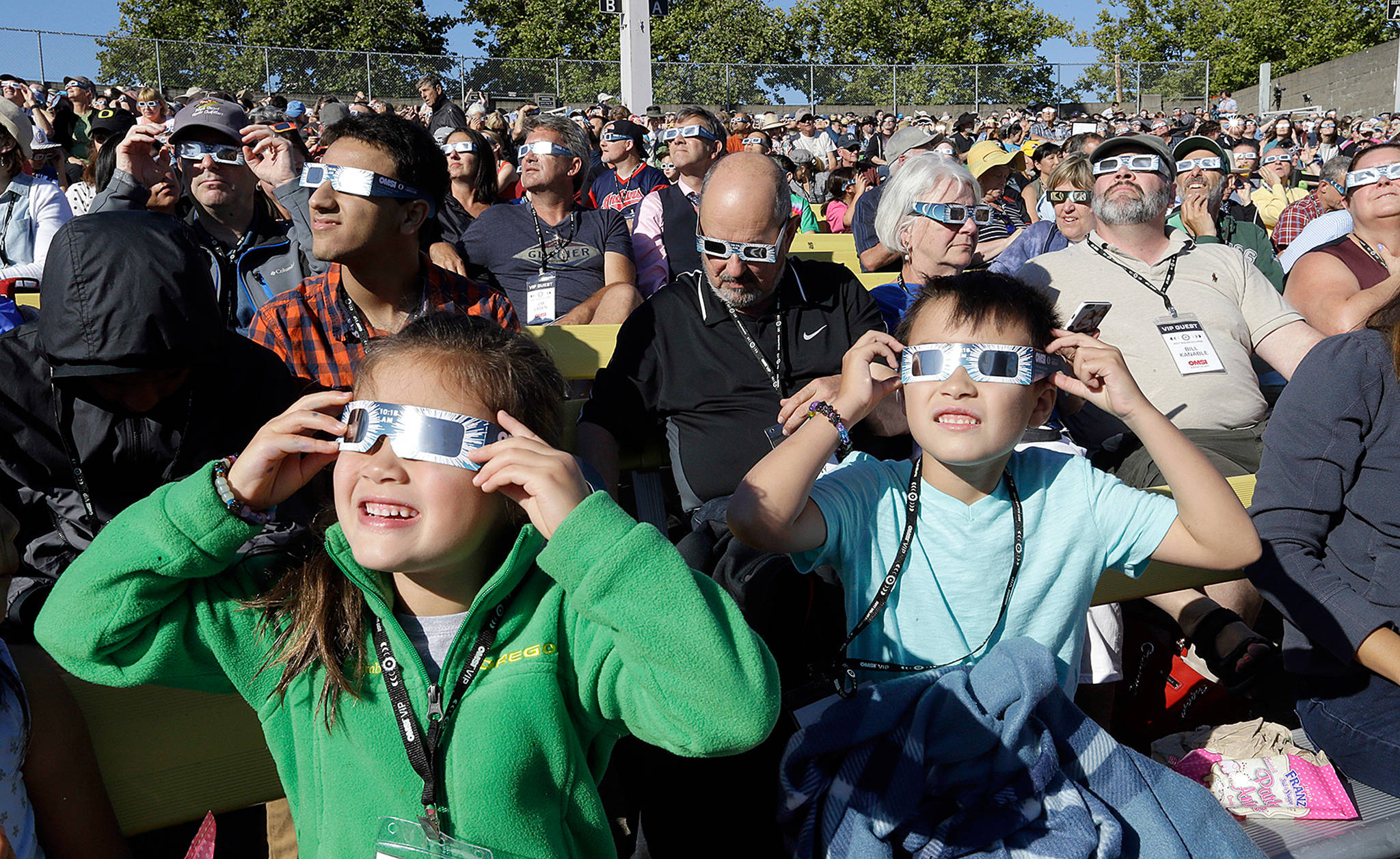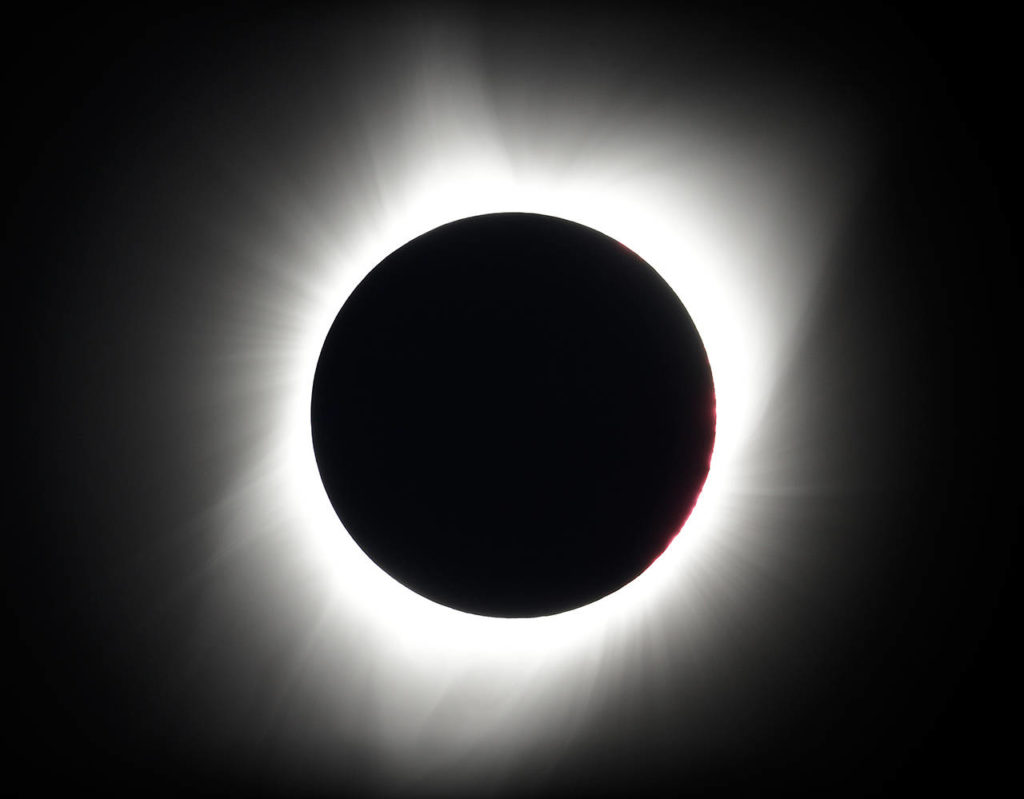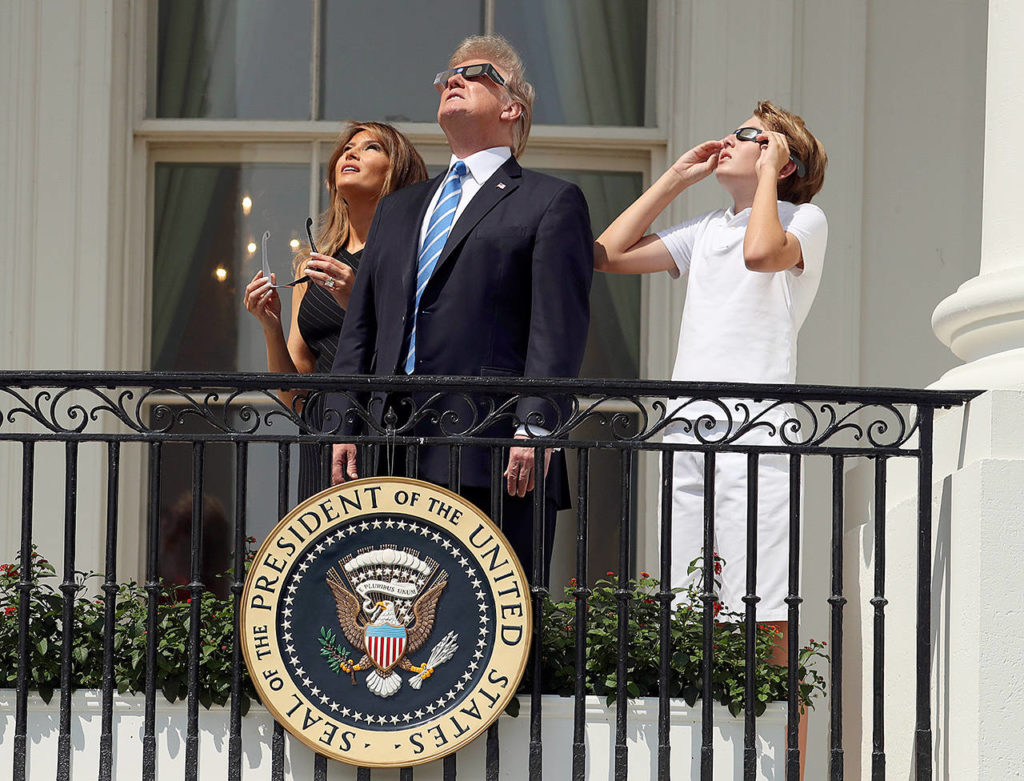Related: We had 90% of an eclipse here, and it was every bit as fun
By Marcia Dunn / Associated Press
Millions of Americans gazed in wonder through telescopes, cameras and disposable protective glasses Monday as the moon blotted out the sun in the first full-blown solar eclipse to sweep the U.S. from coast to coast in nearly a century.
“It was a very primal experience, it really was,” Julie Vigeland, of Portland, Oregon, said after she was moved to tears by the sight of the sun reduced to a silvery ring of light in Salem. “I’ve seen other really magnificent things, but there is nothing, nothing like this. Absolutely nothing.”
The temperature dropped, birds quieted down, crickets chirped and the stars came out in the middle of the day as the line of darkness raced 2,600 miles (4,200 kilometers) across the continent in about 90 minutes, bringing forth oohs, aahs, shouts and screams.
In Boise, Idaho, where the sun was more than 99 percent blocked, people clapped and whooped, and the street lights came on briefly, while in Nashville, Tennessee, people craned their necks at the sky and knocked back longneck beers at Nudie’s Honky Tonk bar.
Passengers aboard a cruise ship in the Caribbean watched it unfold as Bonnie Tyler sang her 1983 hit “Total Eclipse of the Heart.”
At the Nashville Zoo, the giraffes started running around crazily in circles when darkness fell, and the flamingos huddled together, though zookeepers said it wasn’t clear whether it was the eclipse or the noisy, cheering crowd that spooked them.
Several minor-league baseball teams — one of them, South Carolina’s Columbia Fireflies, outfitted for the day in glow-in-the-dark jerseys — briefly suspended play.
At the White House, despite all the warnings from experts about the risk of eye damage, President Donald Trump took off his eclipse glasses and looked directly at the sun.
It was the most-observed and most-photographed eclipse in history, with many Americans staking out prime viewing spots and settling onto blankets and lawn chairs to watch, especially along the path of totality — the line of deep shadow created when the sun is completely obscured except for the ring of light known as the corona.
The shadow — a corridor just 60 to 70 miles (96 to 113 kilometers) wide — came ashore in Oregon and then traveled diagonally across the Midwest to South Carolina, with darkness from the totality lasting only about two to three wondrous minutes in any one spot.
The rest of North America was treated to a partial eclipse, as were Central America and the top of South America.
With 200 million people within a day’s drive from the path of totality, towns and parks saw big crowds. Skies were clear along most of the route, to the relief of those who feared cloud cover would spoil this once-in-a-lifetime moment.
NASA reported 4.4 million people were watching its TV coverage midway through the eclipse, the biggest livestream event in the space agency’s history.
“It can be religious. It makes you feel insignificant, like you’re just a speck in the whole scheme of things,” said veteran eclipse-watcher Mike O’Leary of San Diego, who set up his camera along with hundreds of other amateur astronomers gathered in Casper, Wyoming.
John Hays drove up from Bishop, California, for the total eclipse in Salem, Oregon, and said the experience will stay with him forever.
“That silvery ring is so hypnotic and mesmerizing, it does remind you of wizardry or like magic,” he said.
More than one parent was amazed to see teenagers actually look up from their cellphones.
Matt Nagy, of Laramie, Wyoming, said that the eclipse made him “whoop and holler” and that even his two teenage daughters were impressed: “It takes a lot to get a teenager excited about something.”
Astronomers were giddy with excitement. A solar eclipse is considered one of the grandest of cosmic spectacles.
NASA solar physicist Alex Young said the last time earthlings had a connection like this to the heavens was during man’s first flight to the moon, on Apollo 8 in 1968. The first, famous Earthrise photo came from that mission and, like this eclipse, showed us “we are part of something bigger.”
NASA’s acting administrator, Robert Lightfoot, watched with delight from a plane flying over the Oregon coast and joked about the NASA official next to him: “I’m about to fight this man for a window seat.”
Hoping to learn more about the sun’s composition and activity, NASA and other scientists watched and analyzed from telescopes on the ground and in orbit, the International Space Station, airplanes and scores of high-altitude balloons beaming back live video.
Citizen scientists monitored animal and plant behavior as day turned into twilight. About 7,000 people streamed into the Nashville Zoo just to watch the animals’ reaction and noticed how they got noisier as it got darker.
The Earth, moon and sun line up perfectly every one to three years, briefly turning day into night for a sliver of the planet. But these sights normally are in no man’s land, like the vast Pacific or Earth’s poles. This is the first eclipse of the social media era to pass through such a heavily populated area.
The moon hasn’t thrown this much shade at the U.S. since 1918, during the nation’s last coast-to-coast total eclipse. The last total solar eclipse on the U.S. was in 1979, but only five states in the Northwest experienced total darkness.
The next total solar eclipse in the U.S. will be in 2024. The next coast-to-coast one will not be until 2045.
The path of totality passed through 14 states, entering near Lincoln City, Oregon, at 1:16 p.m. EDT, moving over Casper, Wyoming; Carbondale, Illinois; and Nashville, Tennessee, and then exiting near Charleston, South Carolina, at 2:47 p.m. EDT.
Shawnee National Forest in southern Illinois saw the longest stretch of darkness: 2 minutes and 44 seconds.
Kim Kniseley drove overnight from Roanoke, Virginia, arriving in Madisonville, Tennessee, before dawn to get a parking spot at Kefauver Park.
He said he could have stayed home in Roanoke and seen a partial eclipse of 90 percent, but that would have been like “going to a rock concert and you’re standing in the parking lot.”
Associated Press writers Gillian Flaccus in Salem, Oregon; Peter Banda in Casper, Wyoming; Caryn Rousseau in Chicago; Seth Borenstein in Nashville, Tennessee; and Beth Harpaz in Madisonville, Tennessee, contributed to this report.
Talk to us
> Give us your news tips.
> Send us a letter to the editor.
> More Herald contact information.




























